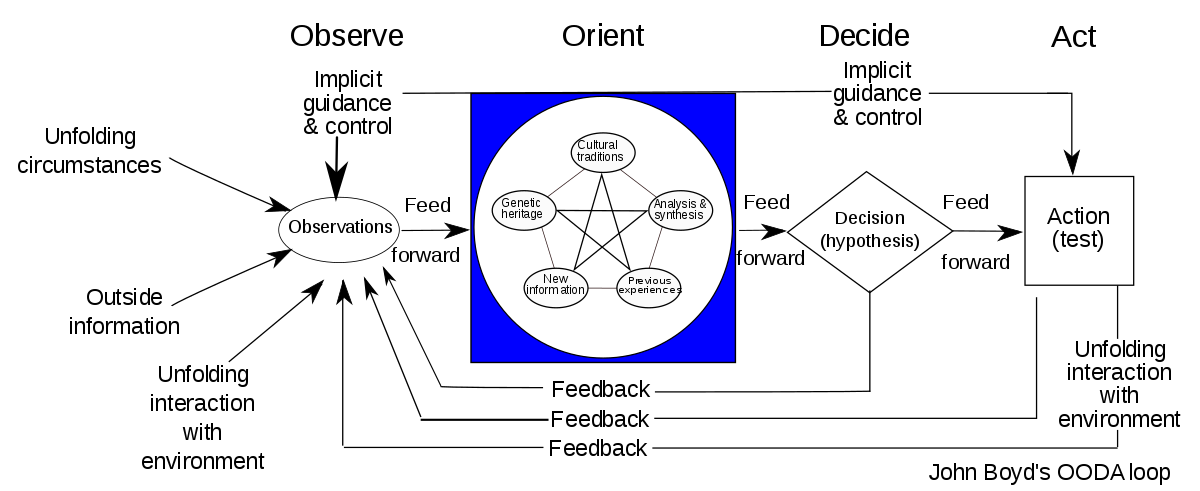Frameworks and models are by definition abstractions of reality. They are not reality themselves. This principle is mostly overlooked in practice because it can be really satisfying to fit your problems into a neat ready-made framework. Thinking with frameworks and mental models is necessary but balancing that with an understanding of nuance is key to implementation. It’s an art. Having said that, one framework caught my attention recently. Not just because it is very satisfying to look at but because of the stakes involved in its usage. Presenting the OODA loop - a framework that fighter pilots use to make accurate and fast decisions. Let’s dive in!
“What is strategy? A mental tapestry of changing intentions for harmonizing and focusing our efforts as a basis for realizing some aim or purpose in an unfolding and often unforeseen world of many bewildering events and many contending interests.”
— John Boyd
The element of surprise
The OODA loop was designed by U.S. Air Force Colonel and military strategist John Boyd. The OODA loop is a four step cyclic process - Observe, Orient, Decide & React. This process was designed to be used at an operating level in military combats. Over the years the idea has found numerous applications across business, litigation, and cybersecurity.
Boyd observed that decision making occurred in cycles of observing, orienting, deciding and acting. Now, the framework itself is not so impressive. If you think about it, this is broadly how we do pretty much everything. Let’s say you want to eat ice cream in today’s VUCA world. You first observe where you can get ice cream and you foresee any obstacles along the way. Then you get ready to orient yourself towards the ice cream and reach its proximity. You then decide to pick it up and finally you act on it to gain custody of the ice cream. Now imagine you go from staying still to suddenly charging fiercely towards it at the store. You are bound to surprise / throw some people off. This was one of Boyd’s primary insights. He observed that was vital to change speed and direction faster than the opponent. This interferes with the opponent’s OODA cycle and increases their probability of making mistakes. In essence this short-circuits the opponent’s thinking process. This kind of agility helps overcome raw power in the form of a ‘stronger’ opponent. Now that’s something to think about.
I have personally never been in such a military combat situation but I can imagine the pressure under which these decisions have to be made. What’s interesting is that this is one field where if an idea doesn’t work it would be replaced immediately with a better one. The fact that the OODA loop stood the test of time says a lot about its practicality.
Competing or ‘market’ cultures
We have seen before that there are fundamentally 4 types of cultures (Competing values framework) - compete, collaborate, control and create. Let’s zoom in on the compete or ‘market’ culture as it is called. This type of organization is oriented towards the external environment. It is focused on transactions with the external stakeholders like suppliers, customers, contractors etc. Emphasis on winning is what that holds the organization together. Members who demonstrate competitiveness and goal orientation consistently usually tend to succeed in these type of organizations. Long story short, the ‘compete’ (and also ‘create’) culture demands agility from its members. Now agility is very hard to define these days given how overused it has become. This still does not take away its importance. The OODA loop presents a refreshing way to look at agility - the ability to short circuit the competitor’s OODA cycle and to test and learn rather than to wait for the perfect solution.
The counter move
The OODA loop encourages proactiveness. Last week we looked at the cost of inaction. The OODA loop just takes that one step further. Now what happens when someone is OODAing you? What can you possibly do?
.…the proper mindset is to let go a little, to allow some of the chaos to become part of his mental system, and to use it to his advantage by simply creating more chaos and confusion for the opponent. He funnels the inevitable chaos of the battlefield in the direction of the enemy.
— Robert Greene
‘Calm down’ is probably the most useless advice ever to give to someone under stress. Now that you know how the OODA cycle works, the first step would be to acknowledge that you are getting OODAed. This is an acknowledgement of the fact that your decision making is getting disrupted. The next step would be to consciously go through the cycle factoring in the fact that you are being disrupted. In other words you need to execute a ‘nested’ OODA loop (too meta?). Let’s say you are a tall and strong basketball player and you find yourself facing an opponent equipped with the knowledge of OODA. The opponent now starts performing a series of fakes looking to create an opportunity for you to make a mistake. The goal is to now out OODA their OODA and create more chaos in a way that generates an advantage rather than merely waiting to react. Happy OODA looping!
You can even go a step further and……





